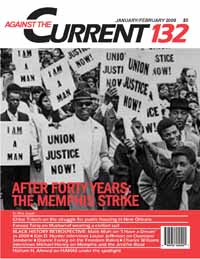Against the Current, No. 132, January/February 2008
-
Devastating Crisis Unfolds
— Bob Brenner, for the ATC Editors -
Behind the Dirty Cleansing of New Orleans
— Chloe Tribich -
Update on Pakistan: After the "Emergency"
— Farooq Tariq -
World Cup 2010: Showcase South Africa
— Sam Ross -
Dubai Labor Fighting Back Vs. Indentured Globalization
— Vicky Francis -
Peace Beyond Annapolis
— Hasan Newash and David Finkel -
HAMAS Under the Spotlight
— Hisham H. Ahmed - The First Legal Russian Strike in a Decade
-
Appreciating Kurt Vonnegut, Jr.
— D.C. Faye - Black Struggle Then and Now
-
Obama and "I Have a Dream" in 2008
— Malik Miah -
Remembrance: Ousmane Sembène, Father of African Film
— Kim D. Hunter interviews Louise M. Jefferson -
Review: Riding the Bus to Freedom
— Dianne Feeley -
Remembrance: Sekou Sundiata and the Dream State
— Kim D. Hunter -
The Making of Jericho Road
— an interview with Michael Honey - Reviews
-
Puerto Rico, The Oldest U.S. Colony
— César F. Rosado Marzán -
Myths of Cultural Dysfunction
— Samuel Farber -
Recovering Forgotten Voices
— Keith Gilyard -
The Death of Retirement?
— Nomi Prins -
Our History Recovered
— Patrick M. Quinn -
Hillary: Hope or Hype?
— Barri Boone - Dialogue
-
A Reply on Overcoming Zionism
— Joel Kovel
THE ALMOST MONTH-LONG strike at the Ford-Vsevolozhsk assembly plant, a small plant near St. Petersburg, ended December 16 with an agreement that negotiations would resume. The strike began on November 17, 2007, after four months of talks failed to produce any result. In fact, Ford management had initially refused to hold negotiations “during or under the threat of strike.”
The Interregional Trade Union of Autoworkers (ITUA) demanded a 30% wage increase, along with an improvement in working conditions; management offered 11%. Striking during the peak sales period, the union was proud it was able to hold out so long. With wages so low that workers can barely keep their heads above water, Russian strikes are usually brief, and most are declared illegal by the courts.
Three days into the strike, two-thirds of the 1500 workers returned to work — but the remaining strikers were enough to keep the plant shut. Of those who returned to work, approximately 600 were absent each day, using different excuses and being paid two-thirds of their wage. The situation remained volatile. Each day 30-40 people would file to go back on strike. By mid-December there were 750 strikers, approximately half the work force. These also constituted a majority of the assembly line.
Management attempted to restart production on November 28, with first shift assembling 66 cars, none of which could pass quality control, since that department was still out on strike. A subsequent attempt occurred on December 11, with two shifts assembling a total of 117 cars.
Alexei Etmanov, head of the plant’s union, pointed out to the St. Petersburg Times (12/18/07) that the end of the strike represented neither a victory or a defeat but just “a new stage in the struggle for our interests.” He pointed out that given the daily production schedule of 350 cars, over the strik’s course the plant failed to produce 5,000 cars.
from ATC 132 (January/February 2008)

